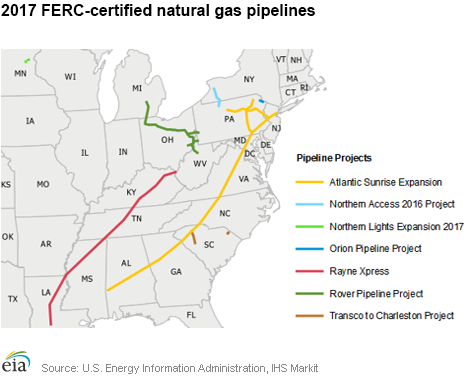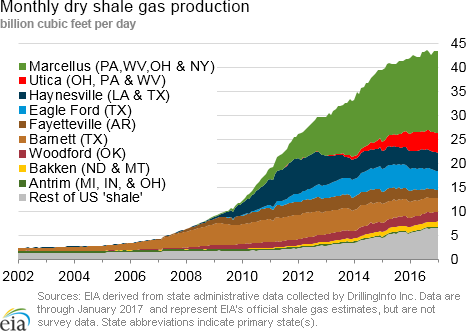In the News:
The Federal Energy Regulatory Commission (FERC) enters a no-quorum period
On February 3, 2017, the Federal Energy Regulatory Commission (FERC) entered into a no-quorum period, with only two of the three required Commissioners needed to establish a quorum. Without a quorum, FERC generally cannot, among other things, issue certifications of natural gas pipeline projects under its jurisdiction. FERC staff can still take limited action in four key areas: accept and suspend rate and other filings, extend times for action on select matters, approve uncontested requests to waive tariff-related terms and conditions, and accept uncontested settlements.
FERC is the governmental regulatory agency for the interstate natural gas pipeline industry. Specifically, FERC regulates interstate transportation rates and services for natural gas pipelines, regulates natural gas pipeline construction, and oversees related pipeline environmental matters. FERC is composed of up to five Commissioners appointed by the President of the United States and confirmed by the United States Senate. Commissioners serve five-year terms and have equal votes on regulatory matters.
In recent years, several large interstate pipeline projects have come online, which support increasing domestic production. In 2016, FERC certified 17.6 billion cubic feet per day (Bcf/d) of pipeline capacity. The United States produced 72.4 Bcf/d of natural gas that same year.
In anticipation of entering a no-quorum period, FERC certified seven projects between January 30 and February 3, 2017. These projects have a total capacity of more than 7 Bcf/d and include more than 1,500 miles in natural gas pipeline construction and expansions.
New 2017 approvals include two large capacity projects, the Rover Pipeline Project (and related projects), which will move natural gas out of the Utica shale play, and the Atlantic Sunrise Pipeline Project, which will move natural gas out of the Marcellus shale play. Other recently certified pipeline projects include the Orion Project, Transco to Charleston Project, Rayne and Leach Xpress, Northern Access, and Northern Lights 2017 Expansion.
However, future approvals could be delayed in the current no-quorum period. As of February 15, 34 projects had FERC applications in process and 20 projects that submitted FERC pre-filings, according to data from PointLogic Energy. These projects, among others, may require quorum approval to proceed.
Overview:
(For the Week Ending Wednesday, February 15, 2017)
- Natural gas spot prices fell across the country this report week (Wednesday, February 8 to Wednesday, February 15). The Henry Hub spot price fell from $3.05 per million British thermal units (MMBtu) last Wednesday to $2.92/MMBtu yesterday.
- At the New York Mercantile Exchange (Nymex), the March 2017 contract fell 20¢ from $3.126/MMBtu last Wednesday to $2.925/MMBtu yesterday.
- Net withdrawals from working gas totaled 114 billion cubic feet (Bcf) for the week ending February 10. Working natural gas stocks are 2,445 Bcf, which is 11% less than the year-ago level and 4% more than the five-year (2012–16) average for this week.
- The natural gas plant liquids composite price at Mont Belvieu, Texas, rose by 1¢, closing at $7.70/MMBtu for the week ending February 10. Spot prices for propane, butane, and isobutane fell by 3%, 2%, and 10%, respectively. Spot prices for natural gasoline and ethane rose by 9% and 11%, respectively.
- According to Baker Hughes, for the week ending Friday, February 10, the natural gas rig count increased by 4 to 149. The number of oil-directed rigs rose by 8 to 591. The total rig count increased by 12, and it now stands at 741.
Prices/Supply/Demand:
Prices fall virtually everywhere. This report week (Wednesday, February 8 to Wednesday, February 15), the Henry Hub spot price fell 13¢ from $3.05/MMBtu last Wednesday to $2.92/MMBtu yesterday. Nationally, weather was milder toward the end of the report period, except for on the Gulf Coast, where temperatures declined Tuesday and yesterday.
At the Chicago Citygate, prices decreased 18¢ from last Wednesday to $2.84/MMBtu yesterday. Prices at PG&E Citygate in Northern California fell 9¢ to $3.30/MMBtu yesterday. The price at SoCal Citygate decreased 1¢ to $3.05/MMBtu yesterday.
Northeast prices down as weather moderates. At the Algonquin Citygate, which serves Boston-area consumers, prices were down $1.49 from $5.51/MMBtu last Wednesday to $4.02/MMBtu yesterday. Prices began the week elevated, with cold weather, and peaked on Thursday as a winter storm moved through the region, knocking out power for over 80,000 customers, mostly in Massachusetts.
Similar to Algonquin, at the Transco Zone 6 trading point for New York City, prices decreased $1.39 from $4.50/MMBtu last Wednesday to $3.11/MMBtu yesterday.
Tennessee Zone 4 Marcellus spot prices decreased 15¢ to $2.46/MMBtu yesterday. Prices at Dominion South in northwest Pennsylvania fell 16¢ to $2.64/MMBtu yesterday.
March Nymex contract down. Following the Henry Hub price, the price of the March 2017 Nymex contract decreased 20¢ over the report period, closing at $2.925/MMBtu yesterday. Weather forecasts of warmer-than-normal temperatures in the coming days may be applying downward pressure on the futures price. The price of the 12-month strip, which averages March 2017 through February 2018 futures contracts, declined 14¢ to $3.248/MMBtu.
Supply increases slightly. According to data from PointLogic, the average total supply of natural gas rose by 1% compared with the previous week, driven by net imports. Dry natural gas production remained constant week over week, whereas average net imports from Canada increased by 9% over the report period.
Demand falls. Total U.S. consumption of natural gas fell by 4% compared with the previous report week, according to data from PointLogic. Outside of the Northeast, average temperatures for this report week were generally warmer than last report week. Week-over-week, power burn declined by 2%, industrial sector consumption decreased by 2%, and residential and commercial sector consumption declined by 7%. Natural gas exports to Mexico increased 3%.
U.S. LNG exports. Natural gas pipeline deliveries to the Sabine Pass liquefaction terminal averaged 2.0 Bcf/d for the report week, 6% lower than in the previous week. Four vessels (combined LNG-carrying capacity of 14.0 Bcf) departed Sabine Pass last week.
Storage:
Unseasonable mild temperatures during the week contribute to smaller than average net withdrawals. Net withdrawals from storage totaled 114 Bcf, compared with the five-year (2012–16) average net withdrawal of 156 Bcf and last year's net withdrawals of 136 Bcf during the same week. Warmer temperatures throughout the week for most of the Lower 48 states contributed to decreased heating demand for natural gas and lower withdrawals from storage. Working gas stocks total 2,445 Bcf, which is 87 Bcf more than the five-year average and 303 Bcf less than last year at this time.
Surplus of working gas to the five-year average climbs by 42 Bcf. Working gas stocks increased compared with the five-year average for the third time in the last four weeks. In the South Central salt region, the surplus relative to the five-year average totaled 115 Bcf—by far the largest in the Lower 48 States. The Midwest region was 57 Bcf more than the five-year average, and the surplus in the Mountain region was 8 Bcf. Elsewhere, working gas stocks are below the five-year average. The East and Pacific regions are 42 Bcf and 41 Bcf below their five-year averages, respectively, while the South Central nonsalt region is 11 Bcf below its five-year average. Working gas stocks in the Pacific region have lagged behind the five-year average since last August as a result of the shut-in at the Aliso Canyon facility. Working gas stocks in the South Central salt region have topped the five-year average for 97 weeks in row—a streak that dates back to April 10, 2015, and likely can be attributed in part to the ongoing expansion of storage facilities in the region since 2013. After dipping below its five-year average for the first time since October 23, 2015, on January 13, 2017, working gas stocks in the Midwest region have increased for four consecutive weeks.
Working gas stocks on pace to end the 2016–17 heating season above 1,900 Bcf. If working gas stocks follow the five-year average for the remainder of the heating season, they will total 1,885 Bcf on March 31. So far in 2017, net withdrawals are 11% below the five-average. Following this slower-than-normal pace, working gas stocks will total 1,948 Bcf by the end of the heating season, which would mark the third time since 2011 that working gas stocks ended the heating season above 1,900 Bcf. The only other times working gas levels topped this threshold at the end of the heating season were in 2012 and in 2016, when working gas totaled 2,473 Bcf and 2,470 Bcf, respectively. Both of these heating seasons were characterized by warmer-than-normal temperatures and relatively light heating demand for natural gas.
Net withdrawals fall below range of market expectations; natural gas prices on the Nymex decrease. According to the Bloomberg survey of natural gas analysts, estimates of net natural gas withdrawals from storage generally ranged from 122 Bcf to 141 Bcf, with a median of 126 Bcf. The price of the Nymex futures contract for March 2017 delivery at Henry Hub fell 4¢/MMBtu to $2.88 MMBtu in 1,802 trades at the release of the Weekly Natural Gas Storage Report (WNGSR).
Unseasonably mild temperatures prevail throughout the Lower 48 states. Temperatures in the Lower 48 states averaged 40°F, which was 5°F higher than normal and 1°F higher than last year at this time. This pattern prevailed throughout the Lower 48 states. In particular, the heavy heating demand regions of the New England and Middle Atlantic regions were 5°F higher than normal, while the East North Central and West North Central were 4°F and 3°F higher than normal, respectively. Heating degree days (HDD) in the Lower 48 states totaled 178, compared with 185 last year and a normal of 212.
See also:
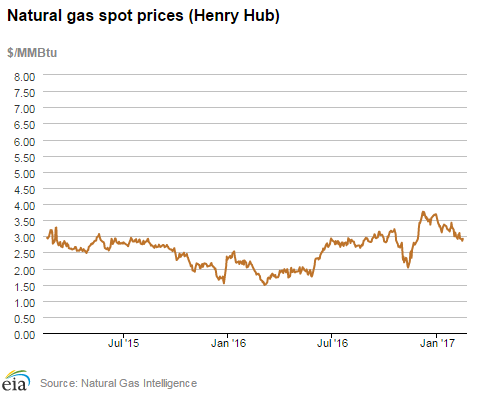
| Spot Prices ($/MMBtu) | Thu, 09-Feb |
Fri, 10-Feb |
Mon, 13-Feb |
Tue, 14-Feb |
Wed, 15-Feb |
|---|---|---|---|---|---|
| Henry Hub |
3.10 |
2.93 |
2.91 |
2.86 |
2.92 |
| New York |
4.94 |
2.85 |
2.90 |
2.88 |
3.11 |
| Chicago |
3.00 |
2.86 |
2.86 |
2.85 |
2.84 |
| Cal. Comp. Avg.* |
3.11 |
2.94 |
2.95 |
2.92 |
2.94 |
| Futures ($/MMBtu) | |||||
| March contract | 3.141 |
3.034 |
2.944 |
2.905 |
2.925 |
| April Contract |
3.209 |
3.117 |
3.032 |
3.005 |
3.037 |
| *Avg. of NGI's reported prices for: Malin, PG&E Citygate, and Southern California Border Avg. | |||||
| Source: NGI's Daily Gas Price Index | |||||
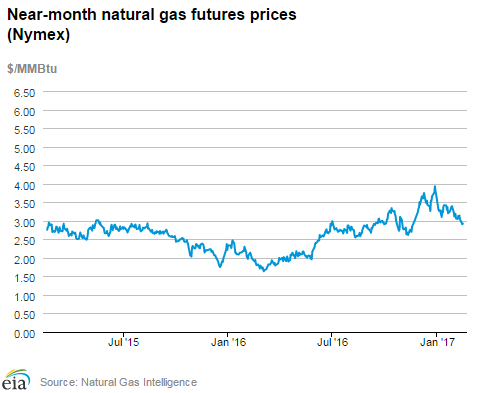
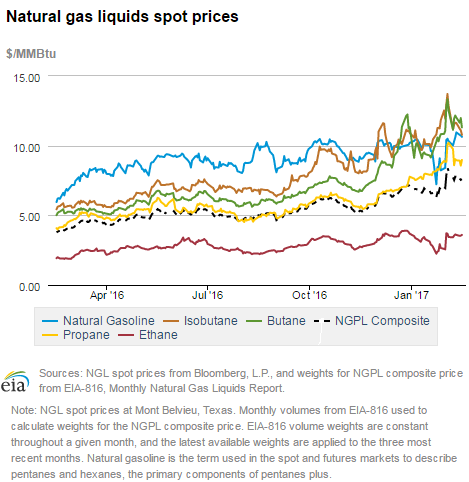
| U.S. natural gas supply - Gas Week: (2/9/17 - 2/15/17) | |||
|---|---|---|---|
Average daily values (Bcf/d): |
|||
this week |
last week |
last year |
|
| Marketed production | 78.4 |
78.8 |
82.4 |
| Dry production | 70.0 |
70.3 |
73.8 |
| Net Canada imports | 6.4 |
5.9 |
7.1 |
| LNG pipeline deliveries | 0.2 |
0.1 |
1.1 |
| Total supply | 76.6 |
76.2 |
82.0 |
|
Source: OPIS PointLogic Energy, an IHS Company | |||
| U.S. natural gas consumption - Gas Week: (2/9/17 - 2/15/17) | |||
|---|---|---|---|
Average daily values (Bcf/d): |
|||
this week |
last week |
last year |
|
| U.S. consumption | 76.9 |
80.0 |
101.4 |
| Power | 21.0 |
21.3 |
25.8 |
| Industrial | 22.1 |
22.5 |
23.9 |
| Residential/commercial | 33.8 |
36.2 |
51.7 |
| Mexico exports | 4.1 |
4.0 |
3.4 |
| Pipeline fuel use/losses | 6.1 |
6.3 |
8.0 |
| LNG pipeline receipts | 2.0 |
2.1 |
0.2 |
| Total demand | 89.0 |
92.3 |
112.9 |
|
Source: OPIS PointLogic Energy, an IHS Company | |||
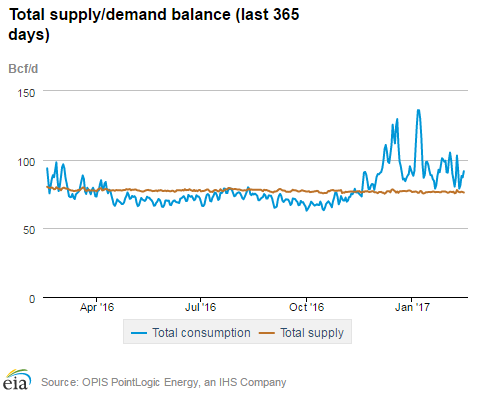
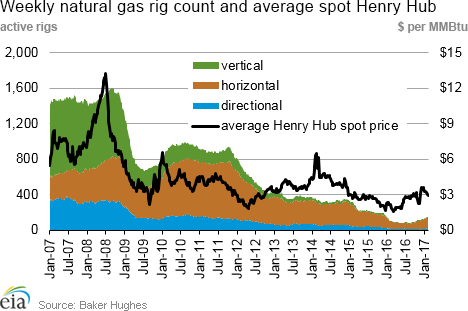
| Rigs | |||
|---|---|---|---|
Fri, February 10, 2017 |
Change from |
||
last week |
last year |
||
| Oil rigs | 591 |
1.4% |
34.6% |
| Natural gas rigs | 149 |
2.8% |
46.1% |
| Miscellaneous | 1 |
0.0% |
0.0% |
| Rig numbers by type | |||
|---|---|---|---|
Fri, February 10, 2017 |
Change from |
||
last week |
last year |
||
| Vertical | 68 |
1.5% |
15.3% |
| Horizontal | 607 |
1.8% |
40.2% |
| Directional | 66 |
0.0% |
34.7% |
| Source: Baker Hughes Inc. | |||
| Working gas in underground storage | ||||
|---|---|---|---|---|
Stocks billion cubic feet (Bcf) |
||||
| Region | 2017-02-10 |
2017-02-03 |
change |
|
| East | 479 |
520 |
-41 |
|
| Midwest | 642 |
685 |
-43 |
|
| Mountain | 150 |
155 |
-5 |
|
| Pacific | 205 |
208 |
-3 |
|
| South Central | 969 |
991 |
-22 |
|
| Total | 2,445 |
2,559 |
-114 |
|
| Source: U.S. Energy Information Administration | ||||
| Working gas in underground storage | |||||
|---|---|---|---|---|---|
Historical comparisons |
|||||
Year ago (2/10/16) |
5-year average (2012-2016) |
||||
| Region | Stocks (Bcf) |
% change |
Stocks (Bcf) |
% change |
|
| East | 583 |
-17.8 |
521 |
-8.1 |
|
| Midwest | 703 |
-8.7 |
585 |
9.7 |
|
| Mountain | 148 |
1.4 |
142 |
5.6 |
|
| Pacific | 256 |
-19.9 |
246 |
-16.7 |
|
| South Central | 1,057 |
-8.3 |
864 |
12.2 |
|
| Total | 2,748 |
-11.0 |
2,358 |
3.7 |
|
| Source: U.S. Energy Information Administration | |||||
| Temperature – heating & cooling degree days (week ending Feb 09) | ||||||||
|---|---|---|---|---|---|---|---|---|
HDD deviation from: |
CDD deviation from: |
|||||||
| Region | HDD Current |
normal |
last year |
CDD Current |
normal |
last year |
||
| New England | 239 |
-31 |
17 |
0 |
0 |
0 |
||
| Middle Atlantic | 221 |
-37 |
20 |
0 |
0 |
0 |
||
| E N Central | 254 |
-29 |
20 |
0 |
0 |
0 |
||
| W N Central | 274 |
-17 |
2 |
0 |
0 |
0 |
||
| South Atlantic | 126 |
-46 |
-29 |
11 |
4 |
6 |
||
| E S Central | 132 |
-40 |
-41 |
1 |
1 |
1 |
||
| W S Central | 68 |
-54 |
-68 |
15 |
11 |
15 |
||
| Mountain | 157 |
-57 |
-72 |
1 |
0 |
0 |
||
| Pacific | 91 |
-17 |
11 |
0 |
0 |
0 |
||
| United States | 178 |
-34 |
-7 |
4 |
3 |
3 |
||
|
Note: HDD = heating degree day; CDD = cooling degree day Source: National Oceanic and Atmospheric Administration | ||||||||
Average temperature (°F)
7-Day Mean ending Feb 09, 2017
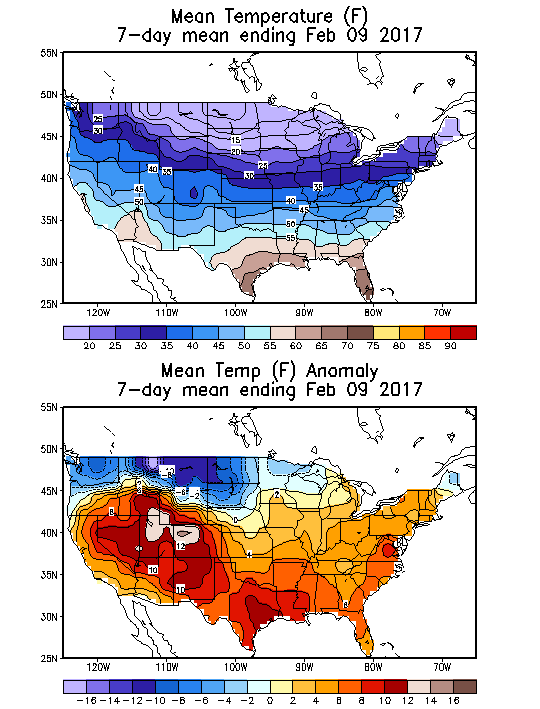
Source: NOAA National Weather Service
Deviation between average and normal (°F)
7-Day Mean ending Feb 09, 2017

Source: NOAA National Weather Service

